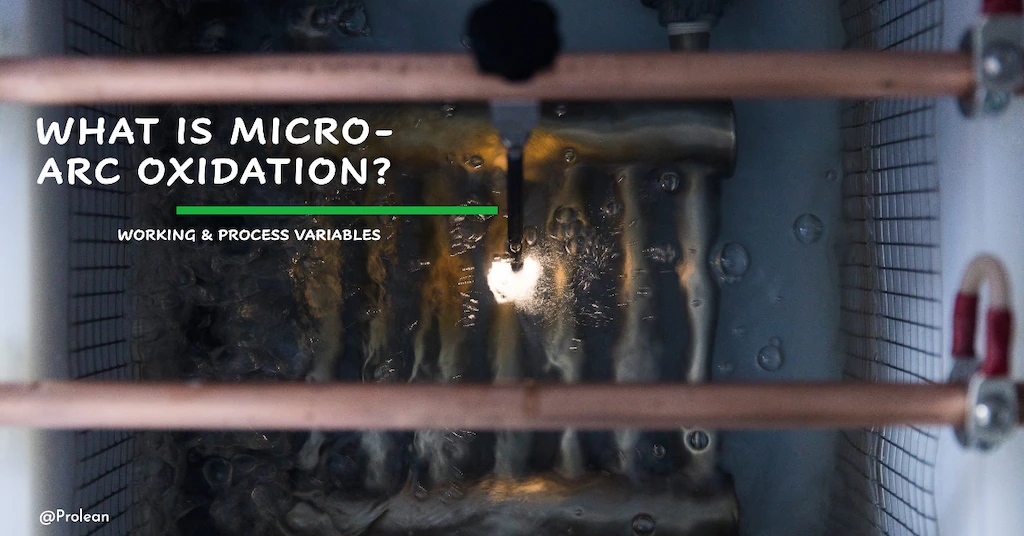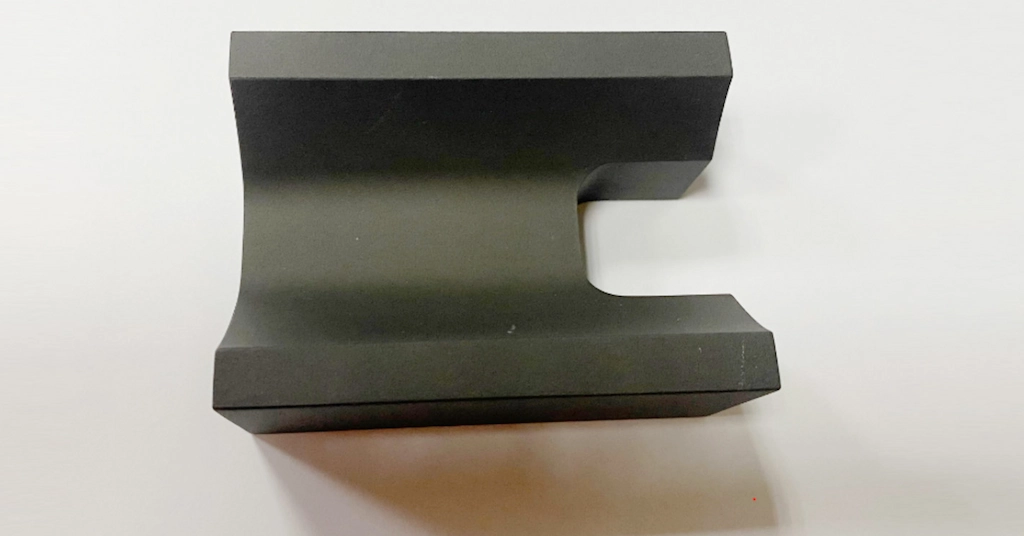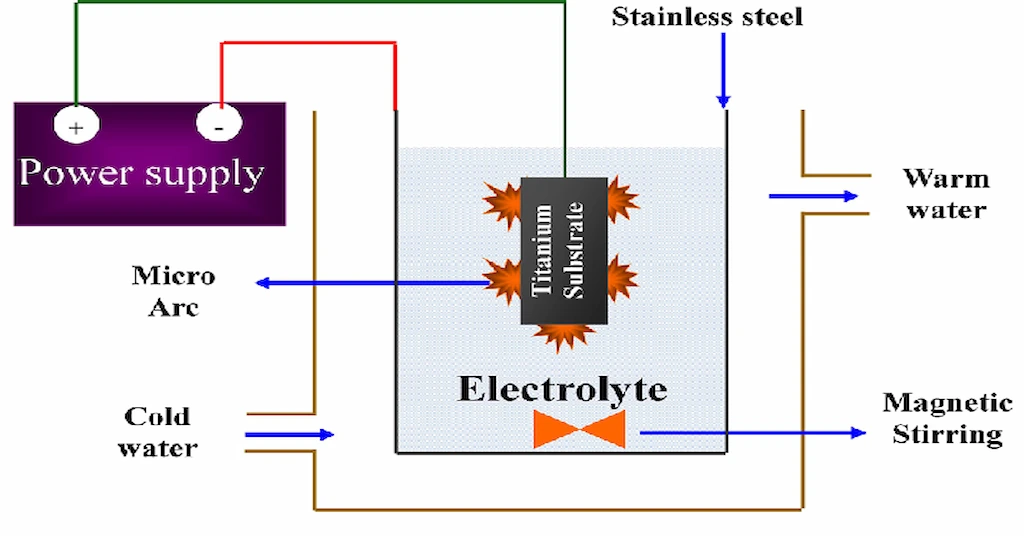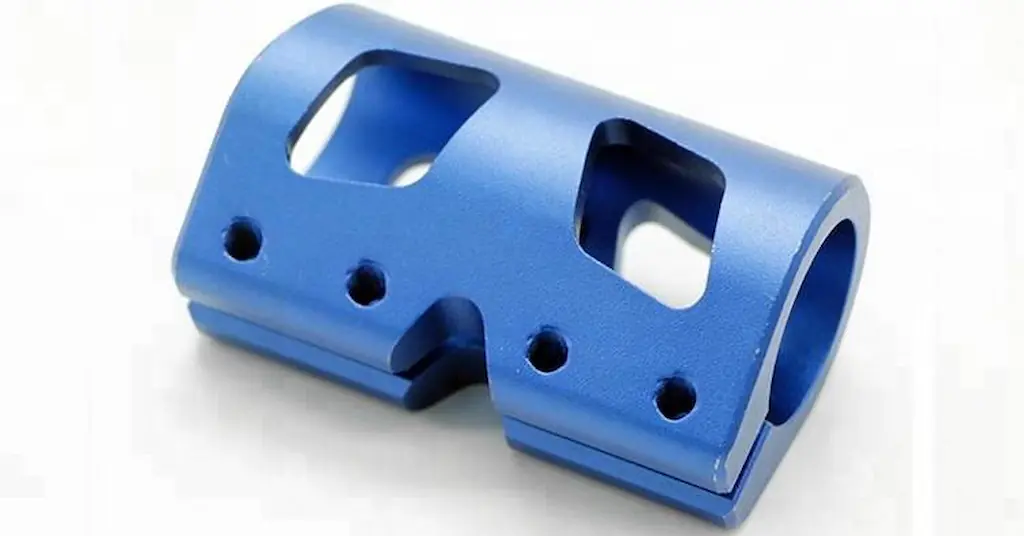“Micro-Arc Oxidation (MAO) is a surface treatment process that enhances wear resistance, corrosion resistance, and hardness through a ceramic-like oxide layer on the surface”

The manufactured parts require a surface finish to enhance the appearance and protect the underlying materials from operational and environmental conditions. Among many protective coating and treatment methods, Micro-Arc Oxidation is used for non-ferrous materials to build a thin oxide layer of substrate material. This hard, wear-resistant, and corrosion-resistant oxide layer improves the product life.
The MAO coating process is based on an electrochemical operation and sparks treatment with high-voltage electric current. You can apply microarc oxidation to aluminum, zinc, magnesium, titanium, copper, etc.
In this article, we will explain what is micro-arc oxidation. Its process, advantages, and applications.
What is Micro-Arc Oxidation?
This metal surface treatment is also known as plasma electrolytic oxidation, a process of developing oxide layers of substrate material using electrochemical and plasma treatment. The process utilizes high voltage ( up to 600 V ) that generates a plasma arc on workpiece electrodes that refines the formed oxide layer into a tougher surface. This hardened oxide layer grows in both directions; inward and outward.

Micro arc oxidation finish
The crystalline oxide coating with micro-arc oxidation increases the product life 2 to 4 times. It acts as a barrier to the external factors, moisture, chemical exposure, temperature fluctuation, etc. The MAO coating also allows to impregnation of different dyes and colors to customize the appearance.
Different industries, automotive, aerospace, military, agriculture, etc use microarc oxidation to make their lightweight components highly resistive to corrosion and wear, enhancing the product life and reliability. The thickness of this hardened oxide coating ranges in micrometers, eg. 20, 40, or 60 µm and higher. Moreover, the surface hardness can be achieved in the range of 1500-2000 HV, whereas it can achieve surface roughness (Ra) of 20 µm or lower.
Try Prolean Now!
The Working Principle Of Micro-Arc Oxidation
The working of micro-arc oxidation is based on electrochemical reactions and plasma arc treatment. First, the electrolysis forms an oxide layer. Then, high voltage plasma arc crystalines the oxide layer. So, it can be compared with the anodizing processes except for the high-voltage plasma treatment. It develops the metal oxide the same way as anodizing does, and the setup is also similar.

Working of micro-arc oxidation process
The MAO Setup:
- Power Supply: High-voltage, high-frequency AC/DC power source
- Electrolyte: Aqueous electrolyte solutions( (often silicate-based)
- Anode: Workpiece (Aluminum, titanium, magnesium alloy, etc.)
- Cathode: Counter electrode (Typically stainless steel or graphite)
- Control system: Computer monitoring and adjustment of parameters, voltage, current, time, etc.
- Process Tank: Made of chemically inert and tough materials like coated hard steel or ceramics.
Next, the following are the steps involved in working of plasma electrolytic oxidation or metal arc oxidation;
Step 1: Metal Oxidation Process
In the first stage, the degreased and thoroughly cleaned workpieces are immersed in the electrochemical bath. Connect the workpiece as an anode and the secondary electrode as the cathode. When the power supply is on ( approx 200V), the anodic reaction takes place;
Metal loses electrons and forms metal ions during the oxidation process.
Let’s take an example of aluminum;
Anodic Oxidation of Aluminum: Al→Al3++3e-
Then, the electrolytic solution decomposes and forms oxygen (O2). The aluminum metal ion reacts with free oxygen and creates an aluminum oxide layer;
2Al3++3O2−→Al2O3
Meanwhile, the thickness of the oxide layer depends on factors like applied voltage, current, processing time, electrolytic type, and material type.
Step 2: Plasma Discharging Process
As the voltage increases, the temperature rises and it creates a discharge on the anode (workpiece) or high temperature. The discharged plasma arc spreads around the workpiece surface and crystallizes the oxide layer.
This high-pressure and temperature process eliminates the surface irregularities and thickness cracks that might present on the anodized layer. Additionally, the resulting hardness can differ on variables like voltage, thickness of oxide layer, etc.
Step 3: Incorporation of Electrolyte Elements
This is the step where you can customize the coating properties of microarc oxidation properties. It means filling the electrolyte elements in the porous surface of the treated workpiece. You can impregnate custom colors and other performance-enhancing additives. This incorporation is permanent and does not fade over time.
What are the Advantages of Micro-Arc Oxidation?
The following are the key advantages of micro-arc oxidation finish
- Comprehensive Coverage
Unlike conventional metal coatings, plasma electrolytic oxidation creates a uniform coating across undercuts, channels, grooves, corners, and edges. So, you get consistent protective properties across the component.
- High Strain Tolerance
The crystalline microstructure of plasma electrolytic oxidation provides high hardness. This structure eliminates thermal deformations or mechanical stress, providing stain tolerance. As a result, the surface wear and crack resistance of your parts increase.
- Superior Corrosion Resistance
The chemically inert, ceramic-like MAO coating surface significantly improves corrosion resistance even in harsh environments. Additionally, you can further customize it to create thicker oxide layers based on the condition where parts will be exposed. Therefore, it can be also a suitable option for pre-treatment for additional protective coatings.
- Dielectric Properties
The micro-arc oxidized surface shows dielectric properties of the substrate surface, which can be archived by controlling the oxide layer thickness during the process. It can achieve dielectric breakdown strength up to 79 kV/mm.
- Thermal Barrier
The inclusion of silicates in the arc oxidation coating process can produce coatings rich in mullite. This serves as an effective thermal barrier, which makes it ideal for coating metal components in high-temperature applications.
What are the Process Variables in Micro-Arc Oxidation?
The final characteristics of the plasma arc oxidized layer pretty much depend on the process variables, from voltage and frequency to PH of the electrolyte. Leveraging the customization of these surface treatment methods is directly connected to the optimization of process variables.
Here is the short brief of key microarc oxidation process variables;
Composition of Electrolyte
Which type of electrolytic solutions are you using? What is the concentration of salts, acids, and other additives? What is the temperature of the electrolyte? What is the pH level of the electrolyte? All of these factors indicate the composition of the electrolyte and directly influence the final properties of the microarc oxidation layer.
Voltage and Current Density
The supplying voltage and current density are critical for initiating and maintaining the plasma discharges that form the oxide layer. Higher voltage and current density lead to quick growth of the coating thickness.
Pulse Mode and Frequency
First, the duty cycle of the pulses affects the microstructure, porosity, and mechanical properties of the coating. Second, High-frequency current forms a uniform layer. Therefore, optimize your pulse mode and frequency.
Process Time
How long is the duration of the treatment process? The longer duration builds thicker coating layers. However, excessive time can cause high porosity and micro-cracking.
Workpiece Material
Different metals may require specific adjustments to the process variables to achieve optimal results. For example, the optimal voltage for aluminum alloys is 300 to 500 V, whereas it is 500 to 700 V for magnesium alloys.
Which Materials Can be Finished with MAO Coating?

Micro arc oxidation on the aluminum surface
The MAO coating is compatible with various metals and alloys, such as aluminum, magnesium, titanium, etc. The table below highlights the key metals and alloys with their brief description;
| Alloys | Grades | Key Properties | Application Examples |
| Aluminum Alloys | 6061, 7075, 2024 | Lowweight material with thermal and electrical conductivity | Aerospace and automotive parts, electronic housings, heat exchangers, etc. |
| Magnesium Alloys | AZ31B, AZ91D | Lightweight and high-strength | Electronics casings, power tools, sporting equipment |
| Titanium Alloys | Ti-6Al-4V, Ti-6Al-2Sn-4Zr-6Mo | High strength, excellent corrosion resistance, biocompatibility | Aerospace components, marine applications, chemical processing equipment, etc. |
| Niobium | C-103, Nb-1Zr | High melting point, excellent corrosion resistance, superconductivity | Superconductors, rocket nozzles, medical implants, etc. |
| Copper Alloys | C11000 C17200 | Excellent electrical conductivity, good thermal conductivity, corrosion resistance | Heat exchangers, plumbing components, architectural items |
Try Prolean Now!
Other Types of Surface Finishing Processes
The micro-arc oxidation is comparable with other two types of surface finishes, anodizing and metal plating. However, the MAO is superior to them in terms of wear resistance and durability.

MAO coating Vs other finishes
- MAO: It uses high voltage to create plasma discharges in an electrolyte, forming a thick and hard oxide layer on light metals like aluminum and titanium.
- Anodizing: It is a lower voltage electrochemical process that produces a thin oxide layer. The layer enhances corrosion resistance and allows for diverse coloring options.
- Metal Plating: It refers to the deposition of a metal layer onto a substrate via electroplating or electroless methods. This finishing offers varying degrees of corrosion resistance, hardness, and aesthetic appeal.
Summing Up
The wear resistance and durability of metal parts can be increased significantly with plasma electrolytic oxidation( or microarc oxidation). This finishing technique comprehensively covers all areas of the component surface uniformly. The crystalline oxide layer can accommodate custom colors and other properties-enhancing additives. Overall, it is ideal for finishing parts that will be exposed to high-performance applications or harsh environments.
At ProleanTech, we provide comprehensive finishing services, including micro-arc oxidation, anodizing, metal coating, and polishing. Our finishing facility is equipped with advanced machinery, and our engineers can achieve custom surface according to your specifications.
FAQs
Why is the microarc oxidation process also called plasma electrolytic oxidation?
Microarc oxidation (MAO) is also called plasma electrolytic oxidation(PEO) because it involves creating a plasma discharge in an electrolytic solution. This discharge generates high energy to form an oxide layer on the material’s surface.
How does the microarc oxidation process work?
Its working mechanism is based on the electrochemical and plasma discharge principle. A high voltage to a metal substrate submerged in an electrolyte creates microarcs or plasma discharges. Then, it oxidizes the metal surface, creating a hard and corrosion-resistant coating.
When to use MAO Coating?
It is ideal for coating metallic components exposed to harsh environments, such as aerospace, automotive, and industrial applications.
Can I apply Micro-Arc Oxidized Coating on any material?
It is primarily applied to light metals like aluminum, titanium, and magnesium. They are not suitable for ferrous metals due to differences in chemical and physical properties.




0 Comments